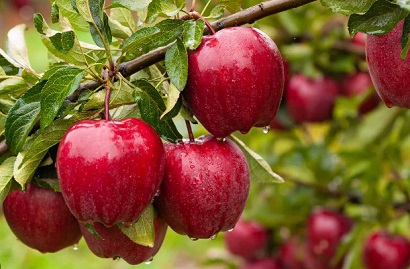Herbs And Phytochemicals: 3,5-Dihydroxybenzoic Acid And Quercetin From Apple Peel and Flesh Are Pro-Neurogenic Phytochemicals
Nikhil Prasad Fact checked by:Thailand Medical News Team Feb 08, 2024 1 year, 2 months, 2 weeks, 4 days, 10 hours ago
Herbs And Phytochemicals: The adage "An apple a day keeps the doctor away" may hold more truth than we realize. Beyond being a dietary staple, apples have been investigated for their potential impact on brain health. As mammals evolved with specific diets, certain naturally occurring compounds in food might have played a role in shaping brain structure and function. In this
Herbs And Phytochemicals exploration, we delve into a study conducted by the Technische Universität Dresden in Germany and the National Institute of Psychiatry “Ramon de la Fuente Muñiz” in Mexico, shedding light on the neurogenic properties of specific phytochemicals found in apple peel and flesh.
 3,5-Dihydroxybenzoic Acid And Quercetin From Apple Peel and Flesh
3,5-Dihydroxybenzoic Acid And Quercetin From Apple Peel and Flesh
Are Pro-Neurogenic Phytochemicals
Understanding Neurogenesis and Dietary Impact
Brain plasticity, the ability of the brain to undergo structural and functional changes in response to internal and external stimuli, is crucial for maintaining cognitive function. A specific form of brain plasticity, adult hippocampal neurogenesis, involves the generation of functional neurons throughout life. Flavonoids, abundant phytonutrients in fruits and vegetables, have been recognized for their potential to modulate molecular signaling pathways influencing cognitive processes. Examples include resveratrol from red grapes and epigallocatechin-3-gallate (EGCG) from green tea. However, the study focuses on apples, one of the most widely consumed fruits globally, to investigate their impact on adult hippocampal neurogenesis.
Quercetin's Complex Role in Neurogenesis
Quercetin, the most abundant flavonoid in apple peel, has been associated with various neuroprotective mechanisms, particularly concerning microglial function. The study reveals that quercetin displays a dual nature in its effects on neurogenesis, being anti-proliferative at high concentrations but pro-neurogenic at lower concentrations. In vitro experiments demonstrate that 25 μM quercetin promotes cell-cycle exit and enhances the survival and differentiation of adult hippocampal neural precursor cells (NPCs). Importantly, in vivo administration of quercetin further supports these findings, indicating a net increase in the generation of new neurons.
Mechanisms Behind Quercetin's Pro-Neurogenic Effects
To understand the underlying mechanisms of quercetin's pro-neurogenic effects, the study conducted RNA microarray analysis, revealing significant changes in gene expression related to oxidative stress, cell cycle, endogenous antioxidative activity, and cell survival pathways. Activation of the PI3K-AKT and NRF2-KEAP1 pathways is proposed to contribute to the pro-neurogenic effects of quercetin. These pathways play vital roles in promoting cell survival, counteracting oxidative stress, and facilitating neurogenesis.
Apple Peel and Flesh: A Source of Pro-Neurogenic Compoun
ds
While quercetin is a key player in apple peel, the study explores the pro-neurogenic potential of compounds in apple flesh. Using a bioassay-guided fractionation approach, researchers identified 3,5-dihydroxybenzoic acid (3,5-DHBA) as a significant contributor to neurogenesis. Even though apple flesh contains lower levels of flavonoids compared to the peel, it exhibits similar pro-neurogenic properties. The neuroprotective effects of 3,5-DHBA are not linked to flavonoids, highlighting its distinct role in promoting neurogenesis.
3,5-DHBA's Impact on Neural Precursor Cells
In-depth investigations into 3,5-DHBA revealed its ability to significantly increase neural precursor cell proliferation and neurogenesis. The study conducted in vivo experiments, administering 3,5-DHBA to adult mice, resulting in a notable rise in the number of proliferating NPCs and newborn neurons in the dentate gyrus. Furthermore, 3,5-DHBA demonstrated a concentration-dependent effect, enhancing the maturation rate of newborn neurons.
Identification of HCAR1 as a Putative Receptor
The study identified hydroxycarboxylic acid receptor 1 (HCAR1) as a putative receptor for 3,5-DHBA. HCAR1, initially considered an orphan receptor, is expressed on neural precursor cells, suggesting a direct mode of action for 3,5-DHBA. Immunocytochemistry and immunofluorescence staining confirmed the expression of HCAR1 on proliferating hippocampal adherent monolayer cells and in the neurogenic niche in vivo.
Conclusion
In conclusion, this comprehensive study unveils the pro-neurogenic potential of specific compounds found in apples. Quercetin from the peel and 3,5-DHBA from the flesh demonstrate multifaceted effects, not only promoting neural precursor cell proliferation but also supporting cell-cycle exit, cellular survival, and neuronal differentiation. The identified mechanisms involving the PI3K-AKT and NRF2-KEAP1 pathways shed light on the intricate interplay between dietary compounds and neurogenesis. As we unravel the complex relationship between diet and brain health, apples emerge as a promising natural source of bioactive compounds with potential implications for cognitive well-being.
The study findings were published in the peer reviewed journal: Stem Cell Reports.
https://www.cell.com/stem-cell-reports/fulltext/S2213-6711(21)00035-7
For the latest on
Herbs And Phytochemicals, keep on logging to Thailand Medical News.
